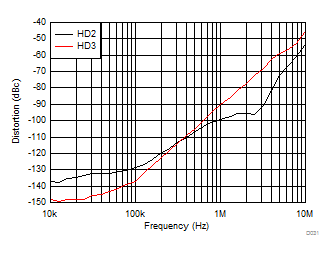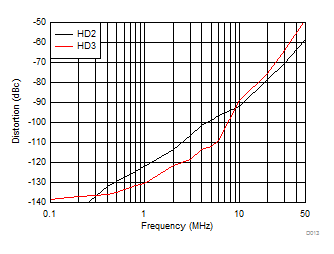-
1MHz Signal-Chain for Wide Bandwidth Data Acquisition
1MHz Signal-Chain for Wide Bandwidth Data Acquisition
Introduction
A wide-bandwidth precision data acquisition circuit (DAQ) is required to measure analog signals with rapid changes in signal amplitude in a short period of time. Even circuits for measuring low-frequency or DC signals need a wide-bandwidth precision data acquisition circuit as the signal multiplexer changes from one input channel to another causing a step change at the output as Figure 1 illustrates.

Figure 1 Multiplexed Wide-Bandwidth DAQ Circuit
In some applications, the analog input signal has high-frequency content and hence the data acquisition circuit needs to have wide bandwidth. Applications that require wide-bandwidth precision data acquisition circuits include electric vehicle traction inverter power analysis and near-field pyroshock testing.

Figure 2 DAQ Circuit for Wide-Bandwidth Analog Signals
1MHz DAQ Circuit
The circuit in Figure 3 includes an ADC (ADS9219), and an ADC driver (THS4541). This ADC driver and ADC circuit are optimized for low distortion and low noise for signals with 1MHz bandwidth making this circuit an excellent choice for use in wide bandwidth data acquisition systems.

Figure 3 Circuit for Measuring an Input Signal With 1MHz Bandwidth
Component Selection
The circuit for driving the analog inputs of an analog-to-digital converter (ADC) needs to have sufficient bandwidth, usually much more than the signal-bandwidth, to handle the kickback from the switched capacitor input of the ADC. However, amplifiers have wide-band voltage noise, usually specified as voltage noise density in the amplifier data sheet, that causes the signal-to-noise ratio (SNR) to degrade as the circuit bandwidth is increased. Hence, there can be a trade-off between low-noise (lower bandwidth) and low-distortion (wider bandwidth) when driving the analog inputs of an ADC. The tradeoff is more pronounced when the analog input signal is high-frequency, which inherently requires a wide-bandwidth circuit.
The Figure 4 and Figure 5 graphs show a comparison of total harmonic distortion (THD) versus frequency for two fully differential amplifiers: THS4551 and THS4541, respectively. The THS4541 has a lower harmonic distortion of –120dB at 1MHz. Therefore, this amplifier is a good choice for designing a low-distortion, wide-bandwidth signal-chain.

Figure 4 THS4551 Harmonic Distortion vs Frequency

Figure 5 THS4541 Harmonic Distortion vs Frequency
When selecting the ADC, the sampling rate and analog input bandwidth needs to be sufficient enough to digitize a wide-bandwidth signal or a fast-changing signal that can be seen at the output of a multiplexer. Based on the Nyquist theorem, the sampling rate of the ADC needs to be twice the analog input signal bandwidth. Practically however, the ADC sampling rate needs to be much more than the signal bandwidth to get a sufficient number of data points for post-processing. Additionally, the analog input bandwidth of the ADC needs to be large enough to reliably sample a fast changing or high-frequency analog input signal.
The challenge with using a much faster ADC compared to the analog input signal bandwidth at 1MHz is that the ADC driver design becomes quite complicated to balance low-distortion and low-noise. This is because the ADC input driver must have high bandwidth to fully charge the sampling capacitor of the ADC between two consecutive samples to maintain low distortion. The ADS9219 has an integrated ADC driver with > 45MHz analog input bandwidth, which means the external circuit does not have to charge the sampling capacitor of the ADC and the ADC has enough analog input bandwidth to reliably digitize a 1MHz analog input signal.
As the ADS9219 has an integrated ADC driver, the THS4541 circuit needs to have just enough bandwidth for a 1MHz analog input with low-distortion. The circuit described in Circuit Optimization shows an example of a wide-bandwidth data acquisition circuit optimized for low-noise and low-distortion for analog input signals up to 1MHz.
Circuit Optimization
To improve the performance of the circuit shown in Figure 3, the following design optimizations were made:
- THD Optimization – To improve the THD of the circuit, RLOAD was increased by setting the feedback resistors to 1kΩ and ZLOAD to 270pF.
- SNR Optimization – The feedback network of the THS4541 circuit generates white noise, so the 270pF differential capacitor and 22pF feedback capacitor are added to limit the signal-chain noise bandwidth.
- Amplifier Stability – To improve phase margin and stability, 50Ω resistors were added in series with the feedback capacitors.
Measurement Results
The THS4541 and ADS9219 circuit was tested with a 1MHz analog input signal. This circuit achieves an SNR of 94.9dBFS and a THD of –104.2dB, as shown in Figure 6. This combination of low noise and low distortion makes the THS4541 and ADS9219 circuits good choices for applications requiring high-fidelity signal processing such as wide bandwidth data acquisition systems.

Summary
Designing a wide-bandwidth precision circuit is crucial for measuring analog signals with rapid changes in signal amplitude in a short period of time. To achieve this, engineers must balance low-noise and low-distortion requirements, which can be challenging, especially when dealing with high-frequency signals. The THS4541 fully differential amplifier and the ADS9219 ADC, which features an integrated ADC driver with high analog input bandwidth is an excellent choice for this application. By optimizing the THS4541 circuit for low-distortion and low-noise, as described in Circuit Optimization, the circuit achieves an SNR of 94.9dBFS and a THD of –104.2dB when driven by a 1MHz input signal. By implementing optimizations for SNR, THD, and amplifier stability, the circuit provides excellent performance making the circuit an exemplary choice for applications needing high-fidelity signal processing, such as power analysis and pyroshock testing.
Trademarks
All trademarks are the property of their respective owners.
IMPORTANT NOTICE AND DISCLAIMER
TI PROVIDES TECHNICAL AND RELIABILITY DATA (INCLUDING DATASHEETS), DESIGN RESOURCES (INCLUDING REFERENCE DESIGNS), APPLICATION OR OTHER DESIGN ADVICE, WEB TOOLS, SAFETY INFORMATION, AND OTHER RESOURCES “AS IS” AND WITH ALL FAULTS, AND DISCLAIMS ALL WARRANTIES, EXPRESS AND IMPLIED, INCLUDING WITHOUT LIMITATION ANY IMPLIED WARRANTIES OF MERCHANTABILITY, FITNESS FOR A PARTICULAR PURPOSE OR NON-INFRINGEMENT OF THIRD PARTY INTELLECTUAL PROPERTY RIGHTS.
These resources are intended for skilled developers designing with TI products. You are solely responsible for (1) selecting the appropriate TI products for your application, (2) designing, validating and testing your application, and (3) ensuring your application meets applicable standards, and any other safety, security, or other requirements. These resources are subject to change without notice. TI grants you permission to use these resources only for development of an application that uses the TI products described in the resource. Other reproduction and display of these resources is prohibited. No license is granted to any other TI intellectual property right or to any third party intellectual property right. TI disclaims responsibility for, and you will fully indemnify TI and its representatives against, any claims, damages, costs, losses, and liabilities arising out of your use of these resources.
TI’s products are provided subject to TI’s Terms of Sale (www.ti.com/legal/termsofsale.html) or other applicable terms available either on ti.com or provided in conjunction with such TI products. TI’s provision of these resources does not expand or otherwise alter TI’s applicable warranties or warranty disclaimers for TI products.
Mailing Address: Texas Instruments, Post Office Box 655303, Dallas, Texas 75265
Copyright © 2025, Texas Instruments Incorporated